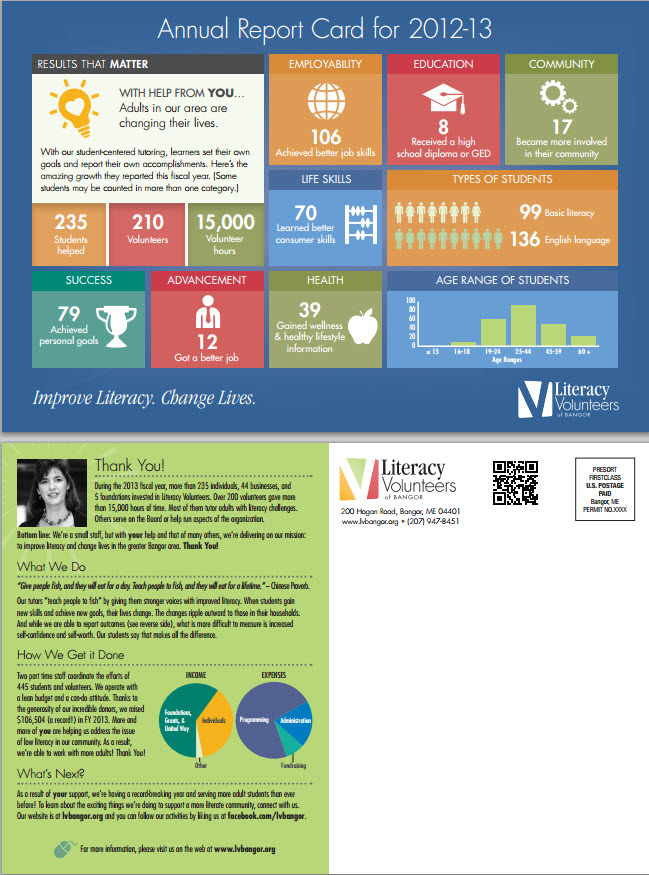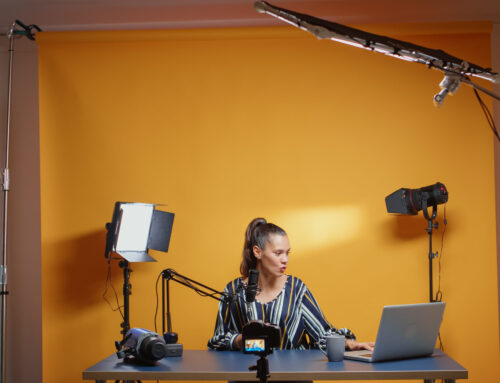Guest Post by Tim Smith
For the past couple of years, Literacy Volunteers of Bangor has been revising their brand. Armed with a new logo and a set of graphic identity standards, we were excited to apply them to our communications. We’ve developed a nice series of appeals and updated our newsletter and website to reflect our new identity. By coincidence, just as the time came to produce our Annual Report, I noticed a webinar from Kivi Leroux Miller about “Producing Annual Reports People Will Actually Read” and decided to attend.
What We Used to Do – The Traditional Annual Report
Literacy Volunteers of Bangor had been doing annual reports that looked great, but tried to mimic the style most often associated with corporate annual reports. These multi-page documents were laid out professionally with charts and graphs, balance sheets, a long introduction by the Executive Director and a lengthy donor list. Once approved, the finished document was made into a PDF and posted to the web site. A broadcast email was then sent to our mailing list to let them know it was available and that was pretty much the end of it. Very few people bothered to download the PDF. Which left me wondering if it was worth the effort.
The Postcard Idea Gets Everyone Excited — But with a Few Concerns
The webinar opened my eyes to some of the creative ways others have turned a stale document into a vital piece of communication. During our next Communications Committee meeting, I shared the webinar slides with the group and described how I thought we could alter our approach. Out of the various samples that were described and illustrated, the group instantly loved the postcard approach that focused on results. The excitement for that direction was amazing, like watching the light bulbs turn on for people.
The two main areas of concern for the group were the elimination of the donor list and letting go of the idea that we had to report results that included organizational changes and internal, administrative successes. However, once the group accepted that our supporters were most interested in seeing the results in terms of our students’ achievements—that their donations were having a real-world effect on people’s lives— things became a lot simpler.
The Annual Report Card Takes Shape
We had the data from the students’ own descriptions of their goals and successes, so it was simply a matter of representing them in a simple, attention-getting format that could have the desired impact and deliver our powerful message. The postcard seemed like the ideal way to deliver that message and became our “Annual Report Card.”
Once finished, it felt like we were closing a conversational loop. So often, we send appeals asking for donations and support. This Annual Report Card allowed us to show the progress people make as a result of the generosity and commitment of our supporters. And, we had a chance to say a big thank you.
Download a Full-Size PDF Version to Get a Better Look
The Response: Donors and Other Supporters Love It!
The response has been immediate and very positive. People love this thing! We’ve received unsolicited comments from our volunteers, donors and even from other non-profits in the area. For instance:
- A volunteer tutor entered a Tutor Training & Support Committee meeting waving the Annual Report Card and stating that she loved it, and took time from the meeting to discuss it with the group. We often focus our communication on donors but it was clear that the tutors/volunteers took great pride in seeing that their efforts are making a difference in people’s lives. Very positive reinforcement for their commitment.
- A friend of one of the Literacy Volunteers staff members works for the local University Development office. She immediately texted her and said “…this is exactly what our school should be doing. Not the boring letters from the Dean.”
- A long-time supporter used the QR code and went right to the mobile version of our website. He loved it and said, “Our nonprofit publishes 16 page glossy reports. I’m bringing this into the office to show the director. This is what we should be doing!”
- During a meeting at the local United Way office, LVB’s Executive Director was interrupted by the marketing manager at United Way who came in holding the Annual Report Card and telling her how much he loved it. He asked permission to copy the approach.
- A donor was enthusiastic enough to call to say that he was gratified to know that his donations could have such a basic yet profound impact on people’s lives.
After working in various corporate marketing communications jobs in Connnecticut, Tim moved to central Maine and started Smith & Powers Communications. For the past 15 years, Tim has designed and consulted for a long list of corporate clients and only recently discovered the joys of volunteering.







